|
British
Columbia Passenger License Plates
|
||||||||||||||||||||||||||||||||||||||||||||||||||||||||||||||||||||||||||||||||||||||||||||||||||||||||||||||||||||||||
Quick Links: |
1904-12 sub-Links: |
| On February 29, 1904, the province enacted the Act to regulate the speed and operation of Motor Vehicles on Highways, which required motorists to have displayed on their vehicle their registration number "so as to be plainly visible at all times during the daylight, such number to be in plain figures not less than three inches in height." |
| Otherwise, motorists were free to be as creative as they wished in the manufacture of their plates, and there are known to be many different types created. In the first year, it appears that a common practice was simply to paint the number directly onto the vehicle. In the photo below (left), John Barnsley (below right) is seen with the No. 1 painted onto an oval disc attached to the side of the vehicle (BC Archives E-00963 - displayed for research purposes only): |
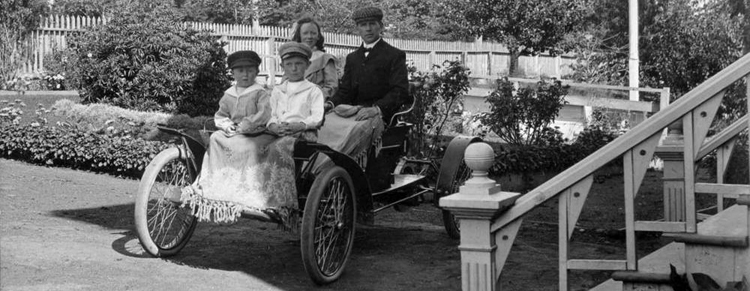 |
 |
 |
Below-left is the vehicle registration card that was issued to John Barnsley in 1904 (courtesy of the Barnsley family). A similar card exists within the BC Archives as well as in a private collection. How can this be? We believe that the letter (below-right) sheds some light on the issue. Writing in 1933, the MVB suggests that copies of the 1904 Registration Card had been made (how many, we don't know): |
|
 |
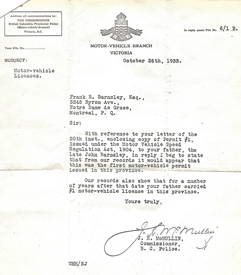 |
The Helmcken's were a prominent Victoria family throughout the 19th and 20th centuries, whose members served as physicians and politicians with a strong interest in local history. At the time that Bastion Square was being re-developed a reporter from the Victoria Daily Colonist newspaper noticed Ainslie James (A.J.) Helmcken (shown below) and asked “if he’d write something for the paper, memories of a boy growing up in Victoria, that sort of thing.” According to his son, James, Helmcken proceeded to write “three columns for the Islander section, all set in the Government Street corridor. That was supposed to be it, but the paper got many requests to continue the stories. So Dad went down to City Hall to dig for more information and discovered they were about to throw away a lot of old records. He was very upset, so offered to sort through and organize them. And that’s how the Victoria City Archives got started.”
One of the articles that Helmcken penned in 1968 recounted the early days of the automobile in Victoria, based on conversations with Horace Plimley, who ran the complany Plimley Motors Limited, which had been started by his father in 1893, and is basically a profile of the first 13 motorists to register their vehicles after the Motor Vehicle Speed Regulation Act was passed in 1904.
License No. 1 - John Barnsley: a gunsmith of Victoria, for an Orient Buckboard ... this car had a two-speed transmission, probably slow and very slow, and was advertised in the Scientific American at the price of $425. It was built after the style of the old buckboards, engine on rear axle, the extra passenger sat in a seat up front over the front wheels. Steering was by tiller. License No. 2 - Captain J.W. Troup: he was the general superintendent of the British Columbia Coast Steamships division of the CPR. At the time he owned this car, his home was Robieda on what was then called Belcher Avenue, but now known as Rockland. License No. 3 - W.M. LePoer Trench: License No. 4 - Dr. E.C. Hart: the well-known physcian, and for many years later the coroner for Victoria district ... he drove [the] car for some time and then sold it to Dr. R. Ford Verrinder, a well-known dentist. License No. 5 - George Collins: he was, I believe a retired gentlemen and later resided on Hillside Avenue. License No. 6: About this time, Gastown (Oops, sorry!), Vancouver was getting into the act. The first licence issued for that place was on March 31, 1904, and the owner was B.T. Rogers, managing director of B.C. Sugar Refinery. |
There is, however, another photo showing a number that has been painted onto a vehicle, which is the No. 22. Can you see it below? |
.jpg) |
 Ok, this is a hard one, so we have zoomed in as best we could and added an arrow to highlight the location of what appears to be 3-inch high numbers in black paint (see image at right). Further helping in this instance is the caption to the photo which describes it as being the interior of the Auto & Cycle Co, East Hastings (1904) and that two of the people in the photo are F.R. Stewart sand William M. Stark. Interestingly, the No. 20 was registered to James Stark (a relation?) on June 23, 1904, while the No. 22 was registered to a W.A. Fenton and I. McIntyre on July 20, 1904. We are going to assume that Fenton and/or Stark are also one of the young gents in this photo. Ok, this is a hard one, so we have zoomed in as best we could and added an arrow to highlight the location of what appears to be 3-inch high numbers in black paint (see image at right). Further helping in this instance is the caption to the photo which describes it as being the interior of the Auto & Cycle Co, East Hastings (1904) and that two of the people in the photo are F.R. Stewart sand William M. Stark. Interestingly, the No. 20 was registered to James Stark (a relation?) on June 23, 1904, while the No. 22 was registered to a W.A. Fenton and I. McIntyre on July 20, 1904. We are going to assume that Fenton and/or Stark are also one of the young gents in this photo.In later years, the a leather base with house numbers attached it would become the most common way to display ones registration number: |
Reflecting the seasonal nature of automobile use in this era, the last registration number issued in 1904 - the No. 32 - was assigned on October 26th to Edward Colley of 54 Government Street in Victoria, while the next number - being the No. 33 - would not be assigned until the following March 8, 1905, to James Dick of Nanaimo. This would change in later years as vehicles were increasingly registered in every month of the year, including December and January. |
The No 1059 (below) showed up on an on-line auction in early 2016 as part of an estate sale in Victoria (along with a series of other plates from 1913 to the 1940s). As with all the plates from this era, its provenance is difficult to prove, but it has many of the characteristics of a pre-provincial plate and, if authentic, was issued to a F. Ware of Victoria on July 15, 1910. To review some of the old Provincial Police / Motor Vehicle Branch Registers from this era, simply click on the image at below-right, or Click Here! |
 |
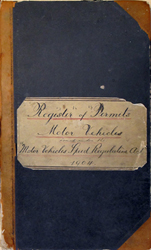 |
|
One of the best ways to now show examples of home-made plates from the pre-provincial era is through photos from the era in which the various styles of plates can be seen on the back of vehicles. This would not be possible without the commitment of the City of Vancouver to an "open-source digital preservation system" that has allowed access to photos that otherwise probably would have remained out-of-sight to collector's and researchers. We commend this approach and can only hope that it is adopted by other institutions (eh-hem, are you reading this City of Victoria Archives staff?). With many thanks to Pierre Delacote for searching out these photos, we have posted a selection in the left-hand column for your enjoyment (higher resolution versions are available at the City of Vancouver Archives web-site). |
 |
 |
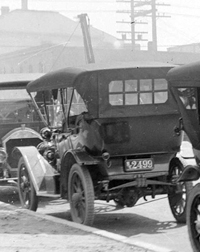 |
 |
 |
One of the Sections of the 1904 Act to regulate the speed and operation of Motor Vehicles on Highways, also required motorists to carry on their vehicles "a lighted lamp, or lamps, in a conspicuous position in such vehicle, whenever in motion in any street, alley or public way, at any time after dusk and before dawn, such light to display prominently the number of the permit issued." |
|
In the image shown at right, the No. 43 is clearly shown on the driver's side lantern. This number was issued on May 3, 1905 to the Vancouver Automobile and Bicycle Company. This photo was taken at the Hollow Tree in Stanley Park. |
|
Below, the No. 122 can be see on the lanterns, which was originally registered to Clarence W. Blackstock of Victoria (i.e. Blackstock & Company - real estate) on February 26, 1907. The driver in this particular photo is recorded as being Mileva Todd. |
|
|
An outing to take in a cricket game somewhere in the Okanagan Valley (possibly Penticton area) The No. 550, visible on the lanterns, was registered a Mr D. Lloyd Jones on Spetember 6, 1909. |
"Dr. A.R. Baker at the wheel of his Model "S" Oldsmobile", and clearly shown on the lanterns on both the driver's side (notice that he is driving on the "wrong side") and the passenger side if the No. 85 which, according to the register at the BC Archives was owned by the Vancouver Auto Cycle Company and was issued on June 11, 1906. |
The No. 1649 was registered to Alfred Johnston of 623 Agnes Street of Vancouver in 1911. This particular photo was taken in front of the hollow tree in Stanley Park. |
The No. 2285 was registered to a number of different individuals and is recorded as being assigned to C.H. Carnworth f 356 16th Avenue in Vancouver in 1911 and to a C.B. Hutton of Vancouver by 1912. We are assuming that neither Mr Carnworth nor Mr. Hutton are shown in this photo driving the vehicle. |
| A Surviving Lantern! |
 |
The No. 1743 was first issued to George J. Fraser of Lakeshore Drive in Penticton around 1911: |
 |
|
Fraser would subsequently relocate from Penticton to Osoyoos, and is shown in the image below standing outside of an Osoyoos shop front many years later (oldphotos.ca).
|
|
 |
|
Prior to this move, it is believed that Fraser sold the Buick that the No. 1743 was registered to. It is further believed that this occurred prior to 1913 and was to another Penticton resident (who subsequently sold the car again in 1918 to someone in the Enderby area).
|
Sometime between 1911 and 1918, one of the the lantern's bearing the No. 1743 registration number was removed from the car and came into the possession of Gordon Harris, proprietor of the Grand Forks Garage Company Ltd of Penticton (shown below - oldphotos.ca).
|
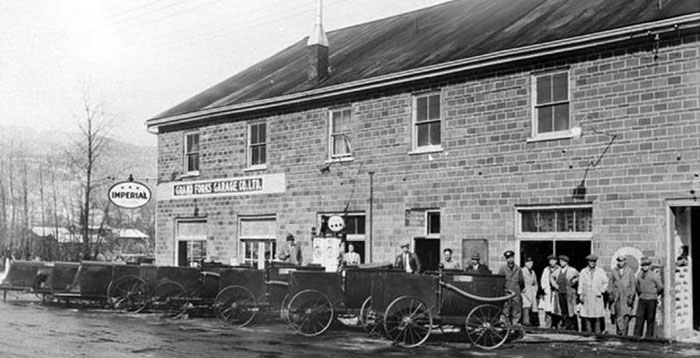 |
In addition to the garage, Harris is also attributed with operating a car dealership in Penticton that "was the first to bring the old Mclaughlin-Buicks here in the carload lots." Importantly, the car that Fraser had registered was a Buick. |
Equally interesting, the local newspaper profiled Harris on the occassion of his retirement and printed his recollections about seeing the first two automobiles come to Penticton, one of which was an Oldsmobile that "was an ornate vehicle with an aluminum body and flowers on the doors" and a copper gas tank - which Harris had held onto as a sort of souvenir. |
This would seem to establish a pattern that Harris kept ornate parts of old vehicles. The lantern with the No. 1743 on it is equally ornate and made of brass. |
While it is not known to us here at BCpl8s.ca where Harris went in his retirement, the lantern stayed within his family over the proceeding decades before finally being made available in early 2018. |
| Attack of the Clones! |
A serious problems during the pre-provincial era of home-made plates was that it was very easy for scofflaws to make and use a duplicate (or clone) of an already issued number in order to avoid paying registration fees or detection by the police (e.g. issuing of tickets). |
Case in point was use of the No. 249 in 1912. The number had originally been issued to the BC Agency Corporation in September of 1907, and the re-assigned to Dr. O.H. Jones in June of 1909. |
In 1912, Dr. Jones was cited for for an infraction on Granville Street in Point Grey and a Summons issued for his attendance at traffic court. |
Problematic, was the Dr. Jones was in California at the time and the caretaker of his property advised the police, upon receipt of the Summons that the car had not been out in Dr. Jones's absence and, even when Jones was home that he rarely drove it into Vancouver. |
In response, the Superintendent of Provincial Police advised his Chief Constable in Vancouver that "should you find that another car is carrying this number, take proceedings against the owner ... [and that] there is no doubt that this is being done [use of a duplicate number] and any person caught should be dealt with severely. [emphasis added] |
| A Plague Upon Our House! |
The scourge of reproduction plates from the pre-provincial era is something that ensnares collectors and car enthusiasts alike and has lead many serious collector's to look upon plates from this era with a skeptical eye due to the high number of reproduction (or fake) plates that have been made over the years. |
Some have estimated that for every genuine plate from the pre-provincial era, there is possibly 10-20 fakes. To find out more and to read about one of the more glaring examples of a reproduction passing for the real thing, Click Here! |
 |
As can be see in the images below, surplus materials from the pre-provincial era are not uncommon and, in the case of the letters and numbers shown, are from a different jurisdiction (likely California) but could easily pass for BC. |
| Pre-Provincial Porcelain License Plate!?!? | |
.jpg) |
|
Dug up near Nanaimo, it is unclear if the item pictured above is an example of a porcelain plate from the pre-provincial era, or merely a house number. To read more about it, Click Here! |
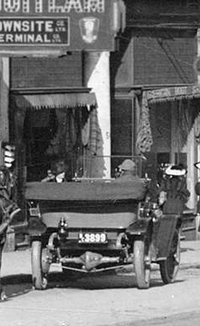 |
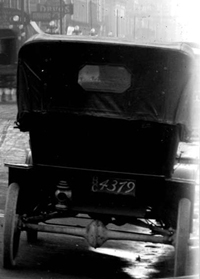 |
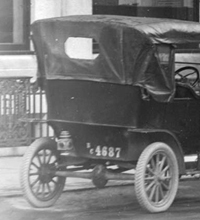 |
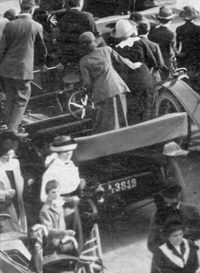 |
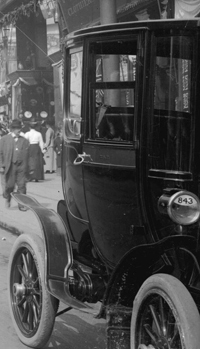 |
 |
||||
 |
One of the reasons that "home-made" in the pre-provincial began to look increasingly alike, and not just in terms of the plates found on other cars in the same jurisdiction, but across different provinces and states is that private companies stepped in and started offering kits that could easily be put together to meet the legal requirements of the motorists home proinvce or state. While the advertisment shown at left is for a New York company, with an office in Ontario, that specialised in leather fenders and "placards", it illustrates this trend. |
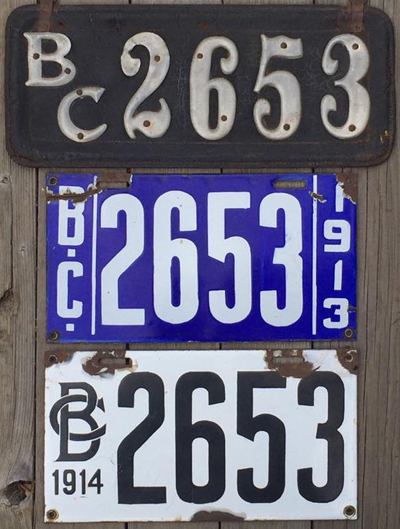 |
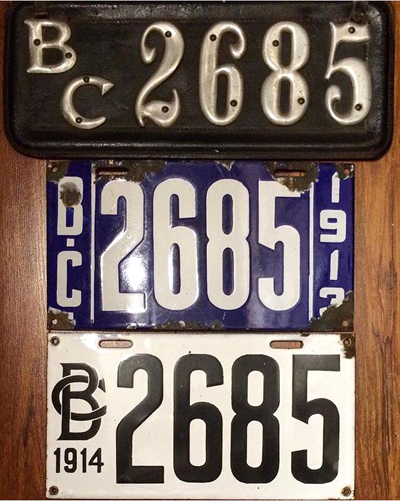 |
A couple of great photos showing the transition from the pre-provincial era to the standard design era introduced in 1913 with the first uniform plates made of porcelain. |
|
Thanks to the records of the Provincial Police / Motor Vehicle Branch, we know that these numbers were first issued to Cadillacs in Victoria and likley from the same dealership - which explains the similarities in the base, letters and numbers used (probably provided by the dealership from a kit). |
|
Even more interesting, the same fellow, F.B. Pemberton, appears to have owned the vehicles to which some of these plates were attached! |
|
 |
While it is known that motorists were required to display their registration number on their lantern (as evidenced in a number of the photos above), this was ended with the introduction of the new Act to Regulate the Use and Operation of Motor-vehicles in 1911. |
More specifically, and instead of the numbered lantern, the new Act now required that "every motor shall be equipped with and shall carry at night a lighted lamp so placed as to illuminate conspicuously at all times between dusk and dawn the number placed on the back of the body of the said motor ..." |
It would seem, however, that old habits die hard as evidenced by the photo above which clearly shows the registration number 5,376 painted on the lantern - despite this number having not been issued until in 1913. |
Shown in this photo is John A. MacDonald (not the Prime Minister), who is one of the gentlemen sitting in the back seat, while the car was registered MacDonald's uncle, A. McDonnell (possibly a spelling mistake) of 1780 1st Avenue in Vancouver. Thanks to Marilyn Robb for sending us this photo and family info. |
| From the X-Files: |
In this installment of the X-Files is a photo that the Vancouver Public Library posted to social media as part of a "Throwback Thursday" (#tbt): |
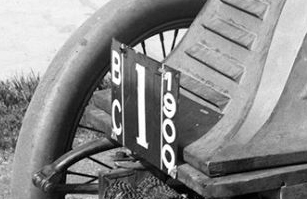 |
The photo at top-left is described by the Library as being the first car in Vancouver and, to prove the point, is sporting a license plate from "1900" with the No. 1 in the middle and the letters "BC" stacked at left. The photo is stated as being taken in 1923 and, thanks to some additional work by the BCpl8s.ca research department we know the photo was used in the August 1924 edition of the Pacific Coast Motorist: |
If the Library wants our two cents (even if they don't, we shared it with them on social media) the so-called license plate is utter bunk and, in the estimatation of us here at BCpl8s.ca, a complete fake. Remember, licence plates were not required until 1904 and the design of this particular plate is a knock-off of the 1913 plates. The absence of pitting and/or chipping of the porcelain suggests to us that this plate is probably painted tin (and is also too thin to be porcelain on steel). |
We are also unsure about the claim that was the first car in Vancouver as it appears to be quite different and more modern than what the City's Archives champion as being the first "horseless carriage" in the city: |
Quick Links: |
1904-12 sub-Links: |
Antique | APEC | BC Parks | Chauffeur Badges | Collector | Commercial Truck | Consul | Dealer | Decals | Driver's Licences | Farm | Ham Radio | Industrial Vehicle | Keytags | Lieutenant Governor | Logging | Manufacturer | Medical Doctor | Memorial Cross | Motive Fuel | Motor Carrier | Motorcycle | Movie Props | Municipal | National Defence | Off-Road Vehicle | Olympics | Passenger | Personalized | Prorated | Prototype | Public Works | Reciprocity | Repairer | Restricted | Sample | Special Agreement | Temporary Permits | Trailer | Transporter | Veteran | Miscellaneous |
© Copyright Christopher John Garrish. All rights reserved.


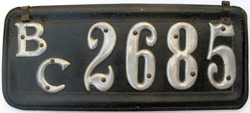
.jpg)
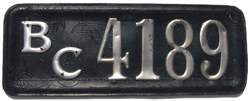
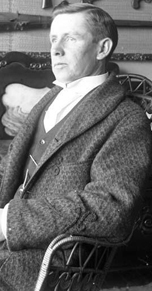









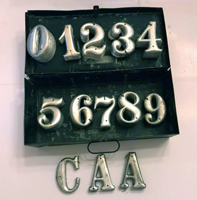
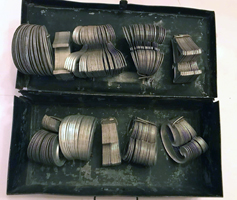
.jpg)
.jpg)
